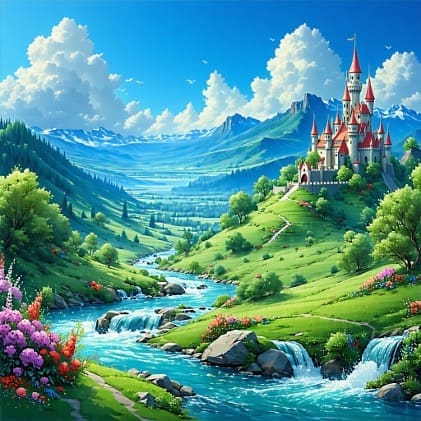Generative AI-powered game design: Accelerating early development with Stability AI models on Amazon Bedrock
In the competitive world of game development, staying ahead of technological advancements is crucial. Generative AI has emerged as a game changer, offering unprecedented opportunities for game designers to push boundaries and create immersive virtual worlds. At the forefront of this revolution is Stability AI’s cutting-edge text-to-image AI model, Stable Diffusion 3.5 Large (SD3.5 Large), which is transforming the way we approach game environment creation.
SD3.5 Large, available in Amazon Bedrock, is Stability AI’s most advanced text-to-image model to date. With 8.1 billion parameters, this model excels at generating high-quality, 1-megapixel images from text descriptions with exceptional prompt adherence, making it ideal for creating detailed game environments at speed. Its improved architecture, based on the Multimodal Diffusion Transformer (MMDiT), combines multiple pre-trained text encoders for enhanced text understanding and uses QK-normalization to improve training stability.
The model demonstrates improved performance in image quality, typography, and complex prompt understanding. It excels at creating diverse, high-quality images across multiple styles, making it valuable for industries such as media, gaming, advertising, and education.
In this post, we explore how you can use SD3.5 Large to address practical gaming needs such as early concept art and character design.
Key improvements in SD3.5 Large compared to SD3 Large
SD3.5 Large offers the following improvements:
- Enhanced photorealism – Delivers detailed 3D imagery with unprecedented realism
- Superior scene complexity – Handles multiple subjects in intricate scenes with remarkable accuracy
- Improved anatomical rendering – Generates more precise and natural human representations
- Diverse representation – Creates images with inclusive representation of skin tones and features without extensive prompting
Real-world use cases for game environment creation
Image generation is poised to revolutionize a few key areas within the gaming industry. Firstly, it will significantly enhance the ideation and design process, allowing teams to rapidly create new scenes and objects, thereby accelerating the design cycle. Secondly, it will enable in-game content generation, empowering users to create new objects, modify avatar skins, or generate new textures. Although current adoption is more prevalent in the design phase, the continued advancement of generative AI is expected to lead to increased user-generated AI content (such as player avatars), which will substantially boost user creativity and overall gaming experience. This shift towards AI-assisted content creation in gaming promises to open up new realms of possibilities for both developers and players alike.
The following are sample prompts for creating early game worlds and their output:
- A vibrant fantasy landscape featuring rolling hills, a sparkling river, and a majestic castle in the distance under a bright blue sky.

- A dense tropical rainforest teeming with exotic plants and wildlife, sunlight filtering through the thick canopy, with a hidden waterfall cascading into a crystal-clear pool.

- A futuristic city skyline at dusk, featuring sleek skyscrapers with neon lights and flying vehicles soaring between them, reflecting on the glassy surface of a river.

The following are sample prompts for creating early game assets and props from different angles:
- An intricately designed realistic game weapon prop of a fiery blue and green blade set against a blurred background of a gargantuan temple. The blade merges geometrical design of the blade with an alien cultural aesthetic.
- Close-up, side-angle view of an intricately designed realistic, game weapon prop of a fiery blue and green blade set against a blurred background of a gargantuan temple. The blade merges geometrical design of the blade with an alien cultural aesthetic.
- Top-down view of an intricately designed realistic, game weapon prop of a fiery blue and green blade set against a blurred background of a gargantuan temple. The blade merges geometrical design of the blade with an alien cultural aesthetic.

Solution overview
To demonstrate the power of SD3.5 Large in game environment creation, let’s walk through a hypothetical workflow. We have provided a Jupyter notebook to deploy a sample gaming use case in the following GitHub repo. Use the us-west-2 AWS Region to run this demo.
Prerequisites
This notebook is designed to run on AWS, using Amazon Bedrock for both Anthropic’s Claude 3 Sonnet and Stability AI model access. Make sure you have the following set up before moving forward:
- An AWS account.
- An Amazon SageMaker domain.
- Access to Stability AI’s SD3.5 Large text-to-image model through the Amazon Bedrock console. For instructions, see Manage access to Amazon Bedrock foundation models.
Define the game world
Start by outlining the core concepts of your game world, including its theme, atmosphere, and key locations. For example, “Mystic Realms is set in a vibrant fantasy world where players embark on quests to uncover ancient secrets and battle mystical creatures. The game features diverse environments, including enchanted forests, mystical mountains, and forgotten ruins. The atmosphere is whimsical and magical, with bright colors and fantastical elements that evoke a sense of wonder.”
Craft detailed prompts for worlds and objects
Use natural language to describe specific environments and objects you want to create. The following screenshot shows some generated prompts.

You can also generate initial concept images with Amazon Bedrock following these steps:
- On the Amazon Bedrock console, under Foundation models in the navigation pane, choose Model catalog.
- For Providers, select Stability AI, then choose Stable Diffusion 3.5 Large.

- Choose Open in playground.

- Enter your prompt and choose Run. A high-fidelity image will be generated in seconds.

Iterate and refine
After you have a base concept you’re happy with, you can generate variations to explore different possibilities for the same environment. Analyze the generated images and refine your prompts to achieve the desired results. You might want to adjust elements like lighting, color palette, or specific environmental features. Finally, use the generated images as reference material for 3D artists to create fully realized game environments.
Clean up
To avoid charges, you must stop the active SageMaker notebook instances if you used the notebook demo. For instructions, refer to Clean up Amazon SageMaker notebook instance resources.
Conclusion
Stability AI’s latest series of models represents a significant advancement in generative AI, providing game developers, designers, and content creators with a powerful tool to enhance creative workflows and explore new dimensions of visual storytelling. By using Stability AI’s capabilities, organizations can address practical gaming needs, from concept art and character design to level creation and marketing campaigns. However, it’s essential to approach this technology with a responsible and ethical mindset, considering potential biases, respecting intellectual property rights, and mitigating the risks of misuse. By embracing these models while being aware of their limitations and ethical considerations, gaming professionals can push the boundaries of what’s possible in game design and visual content creation.
To get started, check out Stability AI models available in Amazon Bedrock.
About the Authors
 Isha Dua is a Senior Solutions Architect based in the San Francisco Bay Area. She helps AWS Enterprise customers grow by understanding their goals and challenges, and guiding them on how they can architect their applications in a cloud-native manner while making sure they are resilient and scalable. She’s passionate about machine learning technologies and environmental sustainability.
Isha Dua is a Senior Solutions Architect based in the San Francisco Bay Area. She helps AWS Enterprise customers grow by understanding their goals and challenges, and guiding them on how they can architect their applications in a cloud-native manner while making sure they are resilient and scalable. She’s passionate about machine learning technologies and environmental sustainability.
 Parth Patel is a Senior Solutions Architect at AWS in the San Francisco Bay Area. Parth guides customers to accelerate their journey to the cloud and help them adopt and grow on the AWS Cloud successfully. He focuses on machine learning, environmental sustainability, and application modernization.
Parth Patel is a Senior Solutions Architect at AWS in the San Francisco Bay Area. Parth guides customers to accelerate their journey to the cloud and help them adopt and grow on the AWS Cloud successfully. He focuses on machine learning, environmental sustainability, and application modernization.




Leave a Reply